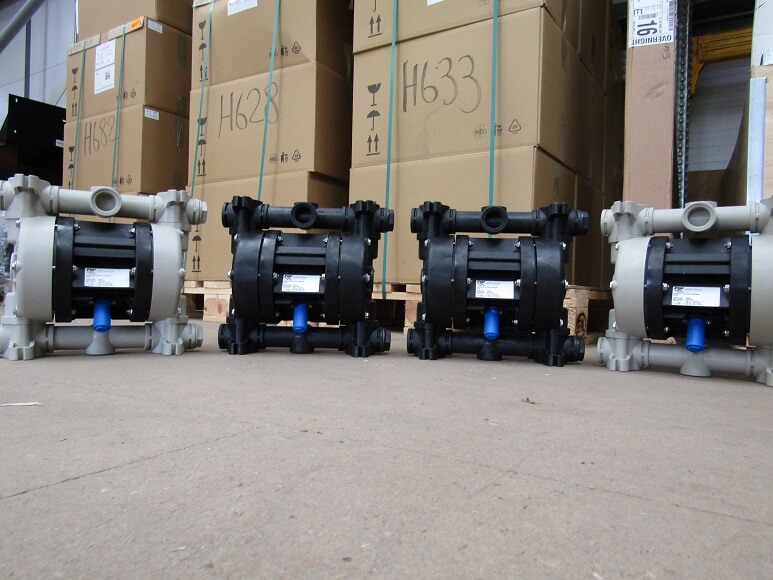Clean In Place CIP Process Diaphragm Pumps
 What is Cleaning in Place?
What is Cleaning in Place?
Cleaning in Place (CIP) is an automated method of cleaning process equipment such as Tanks, Vessels, Pumps, Valves, Heat Exchangers and Fittings without disassembly of parts and resorting to manual cleaning. It is an extremely important process to ensure hygiene levels are maintained, it is most commonly performed in factories producing food, beverage or pharmaceutical products.
There can be 5 Steps in the process which include - Pre-Rinse -> Caustic Wash -> Rinse -> Final Rinse -> Sanitising Rinse.
Various fluids are flushed through pipework at turbulent flows to clean, rinse and sanitise components either in between batches or at set intervals to maintain hygiene within a process. This involves the use of a chemically resistant pump that can produce the required flow rate and pressure to adequately clean the necessary equipment.
Caustic Chemical Transfer
We were approached by a client that uses different acid and alkaline caustic chemicals for their CIP process and they required 4 compatible pumps with 1” connections to produce 1000L/hr to ensure all equipment is cleaned sufficiently.
The pumps will be used for the caustic phase of the CIP process where a non-foaming detergent is circulated at high temperatures (up to 85°C) to remove stubborn deposits in hard-to-reach areas.
Non foaming agents are used as foaming agents can cause issues with CIP recirculation pumps NPSH if foam congregates at the inlet, leading to cavitation. Use of non-foaming agents also ensures tanks or vessels are nor overfilled with foam which can quickly accumulate in spaces and require large amounts of sterilised water to effectively remove.
Each AOD Pump will handle a different chemical, and as each fluid varies in aggressiveness differing materials are needed which is why these pumps are manufactured in both Polypropylene and PVDF. Typically, chemicals such as Sodium Hydroxide, Sulphur Dioxide, Chlorine Dioxide, Hydrogen Peroxide and Nitric Acid are used for CIP cleaning which are dosed or transferred at a set concentration to create an effective caustic wash.
Although the pumps have different casing materials, all the pumps are installed with PTFE diaphragms as this material is chemically resistannt to a wide range of concentrated acids and alkalis, and would minimise on site stockholding as the diaphragms are interchangeable between pump models.
Why Use a Diaphragm Pump for Chemical Transfer
Diaphragm pumps have a broad range of benefits that suit them perfectly for applications such as this, the versatility in material options and performance make them a popular choice when handling aggressive concentrated corrosive chemicals.
Unlike electric powered units that require a variable speed drive, the flow rate is easily controlled by simply increasing or decreasing the air pressure entering the motor. It is possible to lower the speed and decrease the flow rate vastly and due to our patented anti-stall motor design, this can be done without risk of stalling the motor. This feature will be useful for the customer is they decide they require higher flow rates for cleaning in the future or need to dose smaller amounts of chemicals for cleaning other equipment.
Other benefits of our AODD range are:
Various casing material options, including PP, PP + CF, PVDF, stainless steel 316 and Aluminium.
Diaphragms available in NBR, Santoprene, EPDM, Hytrel and PTFE.
Diaphragm lifespan of 50,000,000 cycles.
50% fewer parts than competitors’ models for easier maintenance.
High viscosity fluids and solids handling.
Atex Zone 2 as standard II 3/3 GD c IIB T135°C, available in Atex Zone 1 if required II 2/2 GD c IIB T135°C.
Can run dry without damage.
Can self-prime from dry up to 4m vertically.
Surface mounted installation or as a submersible.
Can run on non-lubricated air.
Flow rate is easily varied by adjusting the air pressure entering the motor.
Patented Anti-stall air motor design.
Configurable suction and delivery port positions
Accessories available including; pulsation dampener, air regulator, stroke counter, batching controller, flange kits and anti-vibration feet.
Food grade versions available if required, these are known as the Food Boxer (FDA) and the SaniBoxer (3A) series.
Below are the specifications of the AODD units that were supplied:
Model: | 2 Qty Boxer 81 Polypropylene Air Operated Double Diaphragm Pumps |
Fluid: | Sodium Hydroxide |
Materials: | PP Casing, PTFE Diaphragms, PTFE Balls, PP Ball seats and PTFE O-Rings |
Flow rate: | Up to 16.67 L/min |
Head: | 6m |
Inlet/Outlet: | Fluid connections 1” (DN25), Air connection 3/8” F |
Motor: | Air |
Model: | 2 Qty Boxer 81 PVDF Air Operated Double Diaphragm Pumps |
Fluid: | Nitric Acid |
Materials: | PVDF Casing, PTFE Diaphragms, PTFE Balls, PVDF Ball seats and PTFE O-Rings |
Flow rate: | Up to 16.67 L/min |
Head: | 6m |
Inlet/Outlet: | Fluid connections 1” (DN25), Air connection 3/8” F |
Motor: | Air |




